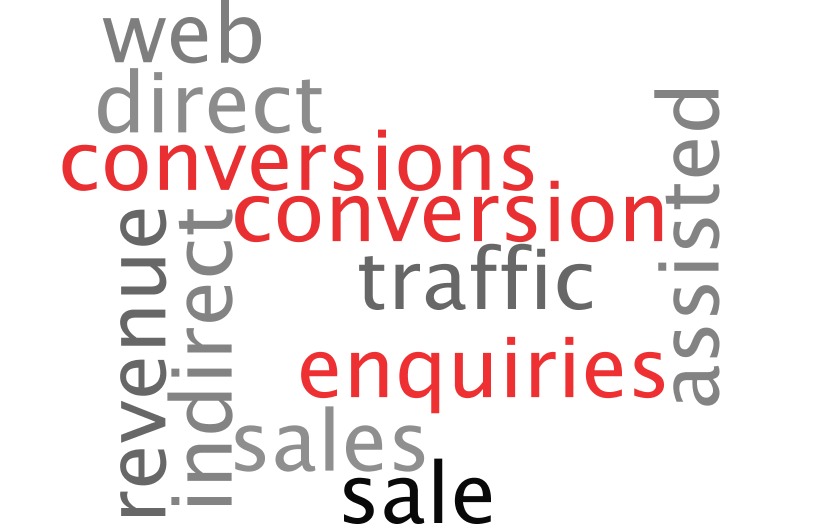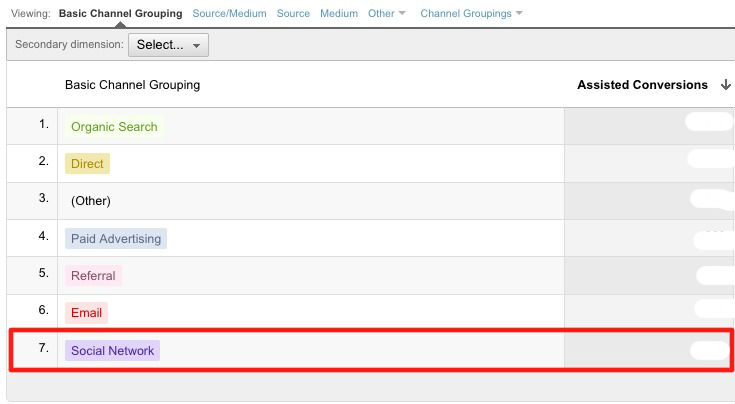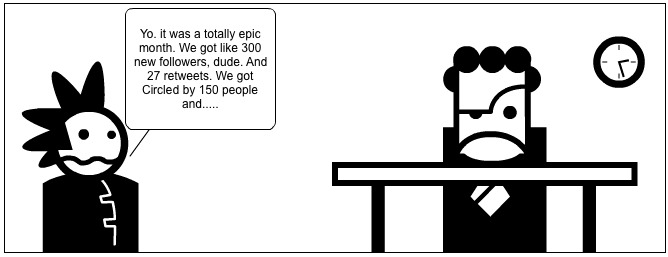SEO and PPC – Easily Measurable
Discussing SEO and PPC campaigns with prospective new clients involves forecasting return on investment. It involves demonstrating exactly what a client could expect to get and estimated time frames for this (based on previous experience). Performance is very clearly and easily measurable.
If SEO and PPC campaigns are there to generate leads, then we, as those in charge of the campaign, will be measured on how many we generate. If it’s e-commerce, we’ll be measured on how many sales we generate and the revenue that brings in. Google Analytics makes it nice and simple to see:
- Traffic
- Conversions
- Assisted conversions
- Return visits
Social – The Challenge of Measurement
Not the words that matter to a client looking for social media's impact on the bottom line!!
Social media, on the other hand, isn’t always as straightforward in terms of measurement. It only takes a swift browse across websites of social media agencies to note that the promised measurements aren’t always as ‘scientific.’
Buzzwords like “interaction,” and “engagement,” like “brand building” and “incentivising” are banded around a LOT in social. I agree – all of those things are important benefits of social media.
But that’s not always as straightforward in terms of measuring and reporting as the metrics we use in measuring SEO and PPC campaign performance. Measuring brand building isn’t something you can do at the end of a given month scientifically with absolute figures to back up what you’re saying.
Social Media – Measurements that Matter

What will fundamentally matter
For a Digital Marketing Agency like ours where the focus is on measurable return, our clients like us to approach campaigns and campaign performance assessment scientifically.
“1172 new people followed your Twitter account and you got 2461 new Facebook fans this month.”
That is a meaningless piece of information to a Marketing Manager with a set budget and a target to hit – and little or no interest in the inner workings of Facebook!
On the other hand:
“Your social media channels generated 2050 visits to your site this month, an increase of 35% on the previous month. These visits directly from these channels to your site converted at 3%, amounting for 62 sales with an average transaction value of £28. Thus, social media directly generated £1,736 through your website this month and w consider a realistic target to be an increase on this of 35% again next month.”
For the clients we deal with, that holds far more value.
Of course, considerations in measuring social like this are that:
- Sales as the result of someone finding you on Facebook, then clicking to your site, then buying your products are a tiny part of the picture.
- Not all campaigns and websites lend themselves to immediate conversion measurement online
- Some conversions are telephone calls
- Some purchases are time sensitive. You can make as much noise on social as you want if you’re a holiday company, for example, but people are still only going to book when they actually want to go on holiday.
There are ways of overcoming these issues and even in situations where it’s not as straightforward as getting a user from Twitter to your site and to a sale, there are measurements that matter more to a marketing manager with a tight budget than the number of Fans and Followers:

An excellent social performance metric – thank you, Google!
- Direct visits and online conversions from social media sites (ideal but not always possible on all campaigns)
- Assisted online conversions – if someone visits from Facebook, leaves without making a purchase and then returns and buys a week later as the result of a brand search in Google, yes it’s a search conversion. However, it was ‘assisted’ by social and this matters.
- Revenue generated directly on your social platforms e.g. if you have a Facebook store etc
- Telephone enquiries (through advanced keyword and source level call tracking) generated directly or indirectly through social media
- Any new natural inbound links acquired as the result of social activity (particularly where you are also running an SEO campaign, as this does have a direct benefit on rankings, which deliver measurable SEO visits/conversions.
Bear in mind though, that while an enquiry or sale from SEO or PPC could be immediate, a sale as the result of some social activity could come months and months after a new customer discovers you socially. These are expectations that need setting right from the off.
Secondary Measurements
Followers, fans, shares, mentions…we know it all matters in getting to the final destination. But these should be secondary metrics. It’s ultimately about what all this activity leads to. Elements we report on in a more secondary fashion include:
- Audience growth
- Level of interaction with your social accounts
- Mentions of your brand on the wider web (looking for month on month growth in line with your social activity)
- Volume of searches for your brand online (again looking for a growth in line with social activity)
“Defluffing”
We’re an agency that reports scientifically. Our clients expect solid analysis from us and figures that mean something. Yes, it’s important to explain how we achieve social success with secondary metrics as discussed above. But ultimately, it comes down to what the client is getting back (whether directly or indirectly) as the result of work we do on the social side of things. Social media, when discussed in the context of ‘sharing, interacting and making people like you’, can seem a little bit ‘fluffy’ and it’s my feeling that it’s this ‘fluffy’ side of social that can be a real barrier to businesses truly understanding the benefits of social media within their overall marketing plan.




